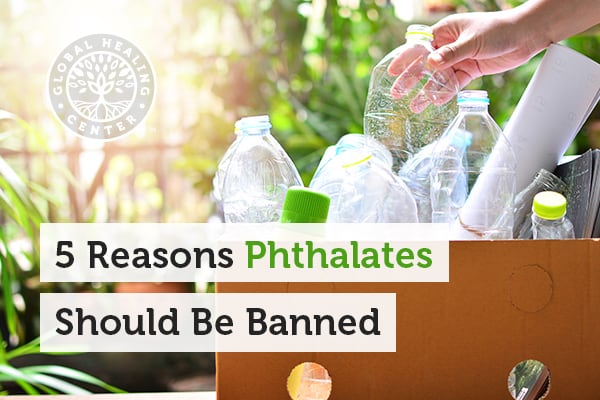
Not that long ago, I talked about 12 ways toxins are sneaking into your life, and while all toxins are bad news, there’s one group that should be banned immediately. I’m talking about phthalates; these are a class of chemicals used to make plastic flexible. For that reason, they’re also commonly referred to as plasticizers. Because they affect reproductive system development, the US government made the smart decision to keep them out of children’s products, banning six of them. This seems like a good thing, right? Well, it’s a start. The concern is there are a lot more than six types, and there’s nothing stopping manufacturers from using unbanned ones. That ban also only deals with kids’ products, so where does that leave the rest of us? Well, if you’re still wondering why phthalates are so bad, here are five reasons they should be banned this instant.
Why Should Phthalates Be Banned?
1. Phthalates Have Infiltrated Children's Food
I mentioned my “12 Toxins” post earlier, and this topic came up there, but I want to talk a little more about it. There’s a fairly mysterious thing happening right now: phthalates are getting into some infant diets and at very high levels. Now logically, you’d think if phthalates are taken out of kids’ products — and, for the most part, they are, since the ban covers the six most commonly used ones — there’d be no room for exposure. But, that's not the case. The contamination is believed to happen somewhere in food processing, or — since phthalates bind to fat molecules — the chemicals might even be in the animal feed and move on from there. Basically, the food is exposed to phthalates before it gets to the table.
2. Phthalates Make Plastic Medical Devices Unsafe
While phthalates might be well regulated in toys, that’s not the case when it comes to medical supplies. These plasticizers are still used heavily in plastic medical devices – the same devices used to keep preemies alive! Most hospitals and clinics don’t regulate how these chemicals are used, so the most vulnerable of infants could be struggling to breathe on a ventilator with plastic tubing. That breathing tube likely contains phthalates that can make their way into the infant's system. A recent study even found that, over time, preemies are exposed to toxic levels that can affect not only reproductive development but also liver function. [1]
3. Phthalates are Destroying Our Ecosystems
Here's another concern – phthalates are contaminating our waterways. Plastic litters our oceans and traditional water bottles are a large culprit. Given that, it makes sense that phthalates will make it into the water supply as those items decompose. Two things can happen: marine life can eat the plastic directly, or just be exposed to phthalates in the water. While it’s still unknown what this toxic marine life means for us, if phthalates are getting into infant diets somehow, could this be a culprit?
4. Phthalates Destroy Hormone Balance
It’s thought that phthalates can disrupt levels of hormones like estrogen and testosterone. I already mentioned that phthalates can affect reproductive health, but there is also a risk for cancer. Don't think you're unaffected, either, do you wear makeup or use a moisturizer? Phthalates are often used to help dissolve ingredients. Do you use hairspray? Manufacturers use plasticizers to keep your hair from becoming too stiff. Studies have even found that your exposure to toxic phthalates is higher based on what personal care products you use. [2] [3]
5. Phthalates are Linked to Asthma
Even more worrying is the possible link to childhood asthma. From 1998 to 2006, scientists studied the phthalate levels in over 300 pregnant women. Research found that the children of the women with higher phthalate levels were 72 to 78 percent more likely to have a diagnosis of asthma than those of the women with low levels; that number is over three times the national average! [4]
References (4)
- Mallow, E.B. & Fox, M.A. Phthalates and critically ill neonates: device-related exposures and non-endocrine toxic risks. Journal of Perinatology 34, 892-897.
- Braun, J., Just, A, Williams, P, Smith, K., Calafat, A. & Hauser R. Personal care product use and urinary phthalate metabolite and paraben concentrations during pregnancy among women from a fertility clinic. Journal of Exposure Science and Environmental Epidemiology 24, 459-466.
- Dodson, R. E., Nishioka, M., Standley, L. J., Perovich, L. J., Brody, J. G., & Rudel, R. A. Endocrine Disruptors and Asthma-Associated Chemicals in Consumer Products. Environmental Health Perspectives, 120(7), 935–943.
- Whyatt, R. et al. Asthma in Inner-City Children at 5–11 Years of Age and Prenatal Exposure to Phthalates: The Columbia Center for Children’s Environmental Health Cohort. Environmental Health Perspectives, DOI:10.1289/ehp.1307670.
†Results may vary. Information and statements made are for education purposes and are not intended to replace the advice of your doctor. If you have a severe medical condition or health concern, see your physician.







